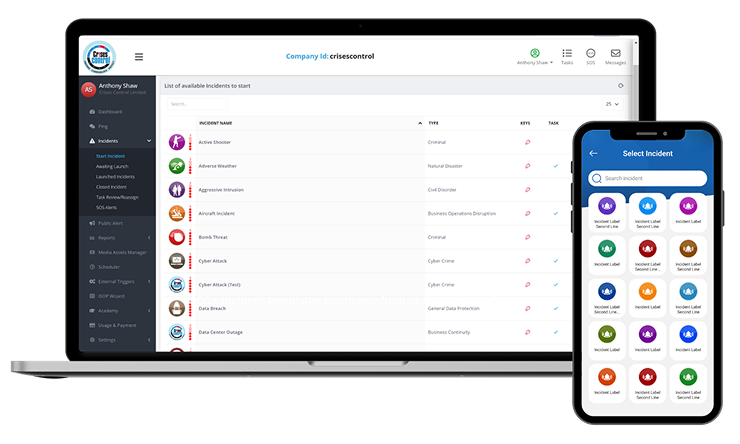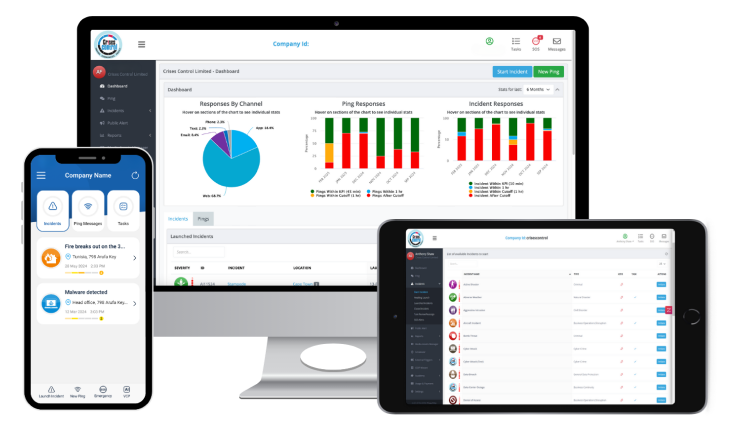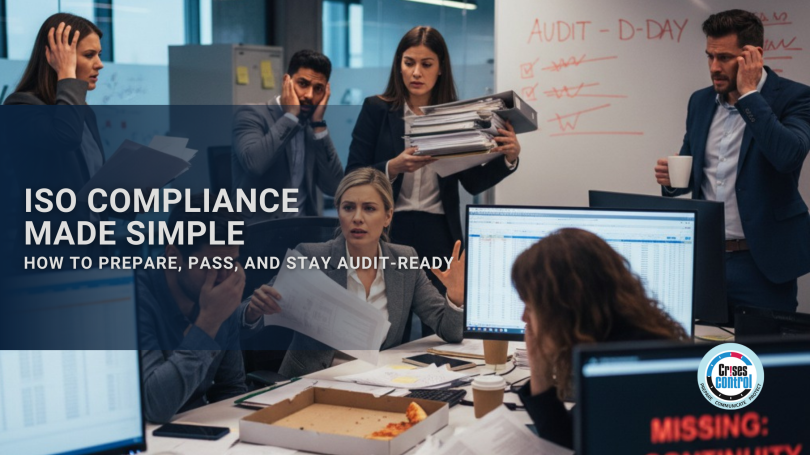Written by Anneri Fourie | Crises Control Executive
Introduction: The Problem with ISO Audits
Picture this: audit week has arrived, and your team is knee-deep in spreadsheets, emails and old reports. Evidence of last year’s continuity test is missing. Incident logs are scattered. You are pulling information together at the last minute, hoping that nothing has been overlooked.
For many organisations, this is the reality of ISO compliance and audits. Standards such as ISO 22301 (Business Continuity), ISO 27001 (Information Security) and ISO 22320 (Emergency Management) are designed to build trust and resilience. Yet for many businesses, preparing for these audits becomes an exhausting exercise in chasing paperwork instead of demonstrating capability.
Over the past few days, we have explored how organisations can meet the specific requirements of ISO 22301, ISO 27001 and ISO 22320. Each has its own focus, but they share a common challenge: showing auditors that systems work in practice, not just on paper.
The good news is that ISO compliance does not have to feel like a burden. With the right preparation, structured workflows, and tools like Crises Control, organisations can move from audit stress to audit confidence.
Why ISO Compliance Feels So Difficult
ISO standards were created to make businesses more resilient. The challenge is that proving compliance takes time and evidence.
Auditors want to see more than policy documents. They look for records of drills, logs of incidents, proof of secure communication and evidence of regular reviews. When this information is spread across different systems or managed manually, gaps appear.
The most common problems are:
- Missing or inconsistent evidence
- Manual processes that are hard to verify
- Lack of real-time data for incidents and testing
- Difficulty showing structured workflows that match ISO requirements
The result is that audits become stressful exercises in firefighting instead of opportunities to demonstrate resilience.
ISO 22301: Business Continuity in Action
ISO 22301 focuses on how organisations prepare for and respond to disruption. It asks a simple but critical question: can you continue delivering your products or services if something goes wrong?
What auditors expect to see
- Documented continuity plans
- Records of regular exercises and simulations
- Business impact assessments
- Evidence that incidents are managed through a clear process
Where businesses struggle
Many organisations create continuity plans but fail to keep them updated or tested. When auditors ask for evidence, they find static documents with no supporting logs or results. This raises doubts about whether continuity arrangements are truly effective.
How to simplify the process
Using business continuity software, organisations can automate scheduling for drills, capture results in real time and maintain audit-ready records. Instead of producing documents on demand, evidence is available at any time.
ISO 27001: Securing Information with Confidence
ISO 27001 is the international standard for managing information security. For organisations handling sensitive or personal data, it is often a regulatory necessity as well as a way to demonstrate trustworthiness.
What auditors expect to see
- Logs of security incidents and responses
- Evidence of access control and monitoring
- Risk assessments and mitigation records
- Secure communication methods that protect sensitive information
Where businesses struggle
Cyber threats change rapidly. Many organisations focus on day-to-day defence but struggle to maintain complete audit trails. Incident records may be incomplete, and communication processes may not meet data protection requirements.
How to simplify the process
By using incident management software for ISO audits, every event can be logged, tracked and resolved with a clear record of actions. Combined with secure crisis communication tools, organisations can prove that sensitive data is handled safely while incidents are managed in a structured way.
ISO 22320: Coordinating Emergency Management
While ISO 22301 and 27001 focus on continuity and security, ISO 22320 sets the standard for emergency management. It is particularly relevant to public sector bodies, healthcare providers and critical infrastructure operators.
What auditors expect to see
- Real-time dashboards for situational awareness
- Structured workflows for incident command and coordination
- Records of multi-agency or multi-team exercises
- Communication strategies for both internal staff and the public
Where businesses struggle
Emergencies often involve many stakeholders. Without a clear command structure and reliable communication, coordination breaks down. Auditors look for evidence that these workflows exist and have been tested.
How to simplify the process
ISO compliance management software can provide predefined workflows aligned with ISO 22320, real-time dashboards for decision-making and automatic logging of activity. This makes it easier to show auditors that emergency management is structured and effective.
How to Prepare for ISO Audits
Preparation is not about creating thick binders of policies. It is about showing that systems work in practice. The following steps make a real difference:
- Centralise your records. Store continuity plans, security logs and incident reports in one system to avoid inconsistencies.
- Automate evidence collection. Let software capture incidents, alerts and test results so that you always have a complete record.
- Run regular drills. Auditors want proof that plans are tested and refined, not written and forgotten.
- Use structured workflows. Whether for crisis communication or incident escalation, make sure your processes are consistent and repeatable.
- Involve your people. Include staff, suppliers and partners in exercises to demonstrate full organisational readiness.
Following these steps turns preparation from a last-minute scramble into an ongoing process that strengthens resilience.
Choosing the Best Software for ISO Audit Readiness
Not all tools are created equal. The best software for ISO audit readiness should support compliance across multiple standards. Look for:
- Secure communication that protects sensitive data
- Multi-channel alerting for rapid response
- Automated audit trails for every action
- Scheduling and tracking of exercises
- Dashboards for real-time visibility
- Reporting aligned with ISO requirements
Crises Control brings all of these elements together in one platform. By combining continuity planning, incident management and emergency communication, it allows organisations to meet the requirements of ISO 22301, ISO 27001 and ISO 22320 without managing separate systems.
From Audit Stress to Audit Success: A Real Example
A financial services company in London faced repeated challenges during its ISO 27001 audits. Evidence of security incidents was scattered across systems, and pulling reports together took weeks.
After adopting Crises Control, incident logs were captured automatically, communication was encrypted and secure, and all evidence was stored in one place. Their compliance manager summed it up clearly:
“For the first time, we walked into an audit confident. Everything the auditor asked for was available instantly. What used to take weeks now takes days.”

Interested in our Incident Management Software?
The Incident Manager enables you to launch and manage incidents in seconds, leveraging real-time dashboards, task automation, multi-channel alerts, and mobile access to coordinate responses seamlessly across your organisation.
ISO Certification Support That Lasts
Achieving certification is one challenge. Maintaining it year after year is another. ISO standards evolve, risks change and auditors expect to see continuous improvement.
Crises Control supports organisations in maintaining ISO certification support by:
- Automating audit trails across ISO 22301, 27001 and 22320
- Providing secure, GDPR-compliant communication
- Offering workflows aligned with international standards
- Delivering dashboards for real-time situational awareness
- Enabling scheduled testing and ongoing review
By embedding compliance into daily operations, organisations can ensure they are always ready for the next audit, not just when certification is due.
Conclusion: Making ISO Compliance Work for You
ISO compliance does not have to feel like an uphill battle. With the right preparation and the right tools, audits can become an opportunity to demonstrate strength, resilience and professionalism.
Instead of chasing evidence at the last minute, organisations can show auditors a clear record of tested plans, secure communication and structured workflows. Whether preparing for ISO 22301, ISO 27001 or ISO 22320, the path to certification becomes simpler when compliance is part of everyday operations.
Now is the time to make audits less stressful and compliance more meaningful.
Contact us today to arrange a free demo and see how Crises Control can help you prepare, pass and stay audit-ready.
Request a FREE Demo

